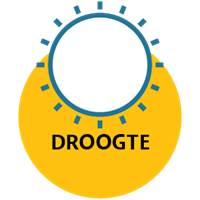How much drier will it be?
Springs and summers are becoming particularly drier, whilst the probability of prolonged drought is growing. But how much drier will it be? Why is drought difficult to predict? And what causes drought?
How much drier is it according to KNMI?
April and May in particular have been drier in recent decades, especially inland. A major cause of this, according to the KNMI'23-scenarios [in Dutch], is that temperatures are rising due to climate change. Another cause is more sunshine as air pollution decreases. The Climate Dashboard [in Dutch] shows that there was a high precipitation deficit especially in the years 2018, 2019, 2020 and 2022.
How much drier will the future be?
The KNMI'23-scenarios show that the probability of extreme drought increases in the future because of decreasing summer precipitation and increasing evaporation. In the most critical scenario, in the case of a drying climate and high CO2 emissions, an average summer around 2100 is about as dry as an extremely dry summer today. In the current climate, an extremely dry year that occurs once every 10 years has a national precipitation deficit of 265 mm. In 2050, this precipitation deficit has increased between 9% and 30%, and in 2100 between 9% and 63%, depending on the climate scenario. The precipitation deficit is expected to increase the most in the southern part of the Netherlands.
The 'Drought' climate scenario in the Climate Impact Atlas shows how drought may become more common in the future. This scenario is based on the KNMI'23 scenarios. You click on the icon for drought and then you can see what may change for the current climate and the four different future scenarios. For example, the precipitation deficit may increase in the future during the summer. The average number of consecutive dry days may also increase.
Why is drought difficult to predict?
According to KNMI, drought remains difficult to predict. This is due to the fact that many different factors affect the volume of water evaporating, e.g., cloud cover, humidity, wind speed, and wetness of the soil, but also the density of tree foliage and tree root depth. In addition, many processes are at play that reinforce and influence one another. Calculating the effects of such processes in models is difficult. For example, dry air will produce less rain and contain fewer clouds. Ergo, solar radiation will be higher, which will lead to more evaporation and thus increased drought.
What is causing the increases in drought?
In the Netherlands, the probability of (extreme) drought is increasing. There are several reasons for this, according to the KNMI'23-scenarios. For example, the Netherlands lies in an area with decreasing summer precipitation, while on the other hand evaporation will increase. The increasing evaporation is mainly caused by higher temperatures, but is amplified by a decrease in cloud cover and thus more solar radiation. Precipitation and evaporation are additionally affected by changes in air currents. West winds usually carry moist air, leading to more precipitation. East winds are usually accompanied by dry air, which can lead to more evaporation, especially in summer. In the most dry KNMI scenario (Hd), dry easterly winds will increase with more cloudless days, especially in the south of the country and in summer. This will increase solar radiation and evaporation.
What else is conducive to drought?
Precipitation volumes affect the precipitation deficit. In terms of drought, however, the type of precipitation also matters. A longer period of drizzle is less conducive to drought than short torrential rains. In short torrential rain, water is drained quickly; only a limited proportion is absorbed by the water system and in the soil. Furthermore, rainwater does not easily seep into dry soil. Another factor that affects drought is the freshwater supply via the rivers Rhine and Meuse. According to KNMI'23-scenarios, the probability of low water in the rivers is expected to increase in summer. This will exacerbate drought conditions. The dry scenarios also show a decrease in annual precipitation, making the recovery of dry summers in subsequent winters even more difficult.
